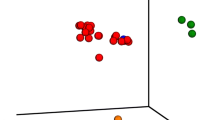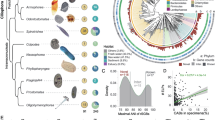Abstract
Protist-bacteria associations are extremely common. Among them, those involving ciliates of the genus Euplotes are emerging as models for symbioses between prokaryotes and eukaryotes, and a great deal of information is available from cultured representatives of this system. Even so, as for most known microbial symbioses, data on natural populations is lacking, and their ecology remains largely unexplored; how well lab cultures represent actual diversity is untested. Here, we describe a survey on natural populations of Euplotes based on a single-cell microbiomic approach, focusing on taxa that include known endosymbionts of this ciliate. The results reveal an unexpected variability in symbiotic communities, with individual hosts of the same population harboring different sets of bacterial endosymbionts. Co-occurring Euplotes individuals of the same population can even have different essential symbionts, Polynucleobacter and “Candidatus Protistobacter,” which might suggest that replacement events could be more frequent in nature than previously hypothesized. Accessory symbionts are even more variable: some showed a strong affinity for one host species, some for a sampling site, and two (“Candidatus Cyrtobacter” and “Candidatus Anadelfobacter”) displayed an unusual pattern of competitive exclusion. These data represent the first insight into the prevalence and patterns of bacterial symbionts in natural populations of free-living protists.


Similar content being viewed by others
Data availability
Sanger nucleotide sequences and metabarcoding raw reads have been deposited in the European Nucleotide Archive (ENA) database under accession numbers OU070010-OU070076 and project number PRJEB44318, respectively.
Code Availability
Not applicable.
References
Husnik F, Tashyreva D, Boscaro V, George EE, Lukeš J, Keeling PJ (2021) Bacterial and archaeal symbioses with protists: functional and evolutionary comparisons with animal models. Curr Biol 31:862–877
Görtz HD (2006) Symbiotic associations between ciliates and prokaryotes. In: Dworkin M, Falkow S, Rosenberg E, Schleifer KH, Stackebrandt E (eds) The Prokaryotes. Springer, New York, pp 364–402
Hafkine WM (1890) Maladies infectieuses des paramecies. Ann Inst Pasteur Paris 4:148–162
Schrallhammer M, Schweikert M, Vallesi A, Verni F, Petroni G (2011) Detection of a novel subspecies of Francisella noatunensis as endosymbiont of the ciliate Euplotes raikovi. Microb Ecol 61:455–464
Boscaro V, Husnik F, Vannini C, Keeling PJ (2019) Symbionts of the ciliate Euplotes: diversity, patterns and potential as models for bacteria–eukaryote endosymbioses. Proc R Soc B 286:20190693
Graf JS, Schorn S, Kitzinger K et al (2021) Anaerobic endosymbiont generates energy for ciliate host by denitrification. Nature 591:445–450
Muñoz-Gómez SA, Kreutz M, Hess S (2021) A microbial eukaryote with a unique combination of purple bacteria and green algae as endosymbionts. Sci Adv 7:eabg4102
Vannini C, Ferrantini F, Ristori A, Verni F, Petroni G (2012) Betaproteobacterial symbionts of the ciliate Euplotes: origin and tangled evolutionary path of an obligate microbial association. Environ Microbiol 14:2553–2563
Boscaro V, Kolisko M, Felletti M, Vannini C, Lynn DH, Keeling PJ (2017) Parallel genome reduction in symbionts descended from closely related free-living bacteria. Nat Ecol Evol 1:1160–1167
Castelli M, Sabaneyeva E, Lanzoni O et al (2019) Deianiraea, an extracellular bacterium associated with the ciliate Paramecium, suggests an alternative scenario for the evolution of Rickettsiales. ISME J 13:2280–2294
Serra V, Gammuto L, Nitla V et al (2020) Morphology, ultrastructure, genomics, and phylogeny of Euplotes vanleeuwenhoeki sp. nov. and its ultra-reduced endosymbiont “Candidatus Pinguicoccus supinus” sp. nov. Sci Rep 10:2031
Potekhin A, Schweikert M, Nekrasova I et al (2018) Complex life cycle, broad host range and adaptation strategy of the intranuclear Paramecium symbiont Preeria caryophila comb. nov. FEMS Microbiol Ecol 94:fiy076
Vannini C, Schena A, Verni F, Rosati G (2004) Euplotes magnicirratus (Ciliophora, Hypotrichia) depends on its bacterial symbionts “Candidatus Devosia euplotis” for a successful digestive process. Aquat Microb Ecol 36:19–28
Beinart RA, Beaudoin DJ, Bernhard JM, Edgcomb VP (2018) Insights into the metabolic functioning of a multipartner ciliate symbiosis from oxygen-depleted sediments. Mol Ecol 27:1794–1807
Boscaro V, Fokin SI, Petroni G, Verni F, Keeling PJ, Vannini C (2018) Symbiont replacement between bacteria of different classes reveals additional layers of complexity in the evolution of symbiosis in the ciliate Euplotes. Protist 169:43–52
Volland JM, Schintlmeister A, Zambalos H et al (2018) NanoSIMS and tissue autoradiography reveal symbiont carbon fixation and organic carbon transfer to giant ciliate host. ISME J 12:714–727
Syberg-Olsen MJ, Irwin NAT, Vannini C, Erra F, Di Giuseppe G, Boscaro V, Keeling PJ (2016) Biogeography and character evolution of the ciliate genus Euplotes (Spirotrichea, Euplotia), with description of Euplotes curdsi sp. nov. PLoS One 11:e0165442
Di Giuseppe G, Erra F, Dini F et al (2011) Antarctic and Arctic populations of the ciliate Euplotes nobilii show common pheromone-mediated cell-cell signaling and cross-mating. Proc Natl Acad Sci USA 108:3181–3186
Bracht JR, Fang WW, Goldman AD, Dolzhenko E, Stein EM, Landweber LF (2013) Genomes on the edge: programmed genome instability in ciliates. Cell 152:406–416
Faktorová D, Nisbet RER, Fernández Robledo JA et al (2020) Genetic tool development in marine protists: emerging model organisms for experimental cell biology. Nat Methods 17:481–494
Heckmann K, Ten Hagen R, Görtz HD (1983) Freshwater Euplotes species with 9 type I cirrus pattern depend upon endosymbionts. J Protozool 30:284–289
Vannini C, Sigona C, Hahn MWH, Petroni G, Fujishima M (2017) High degree of specificity in the association between symbiotic betaproteobacteria and the host Euplotes. Eur J Protistol 59:124–132
Vannini C, Ferrantini F, Verni F, Petroni G (2013) A new obligate bacterial symbiont colonizing the ciliate Euplotes in brackish and freshwater: “Candidatus Protistobacter heckmanni”. Aquat Microb Ecol 70:233–243
Vallesi A, Sjödin A, Petrelli D et al (2019) A new species of the γ-proteobacterium Francisella, F. adeliensis sp. nov., endocytobiont in an antarctic marine ciliate and potential evolutionary forerunner of pathogenic species. Microb Ecol 77:587–596
Rossi A, Bellone A, Fokin SI, Boscaro V, Vannini C (2019) Detecting associations between ciliated protists and prokaryotes with culture-independent single-cell microbiomics: a proof-of-concept study. Microb Ecol 78:232–242
Herlemann DPR, Labrenz M, Juergens K, Bertilsson S, Waniek JJ, Anderrson AF (2011) Transition in bacterial communities along the 2000 km salinity gradient of the Baltic Sea. ISME J 5:1571–1579
Altschul SF, Madden TL, Schäffer AA, Zhang J, Zhang Z, Miller W, Lipman DJ (1997) Gapped BLAST and PSI-BLAST: a new generation of protein database search programs. Nucleic Acids Res 25:3389–3402
Bolyen E, Rideout JR, Dillon MR et al (2019) Reproducible, interactive, scalable and extensible microbiome data science using QIIME 2. Nat Biotechnol 37:852–857
Callahan BJ, McMurdie PJ, Rosen MJ, Han AW, Johnson AJA, Holmes SP (2016) DADA2: high-resolution sample inference from Illumina amplicon data. Nat Methods 13:581–583
Glöckner FO, Yilmaz P, Quast C et al (2017) 25 years of serving the community with ribosomal RNA gene reference databases and tools. J Biotechnol 261:169–176
Werner JJ, Koren O, Hugenholtz P et al (2012) Impact of training sets on classification of high-throughput bacterial 16S rRNA gene surveys. ISME J 6:94–103
Katoh K, Standley DM (2013) MAFFT multiple sequence alignment software version 7: improvements in performance and usability. Mol Biol Evol 30:772–780
Nguyen LT, Schmidt HA, von Haeseler A, Minh BQ (2015) IQ-TREE: a fast and effective stochastic algorithm for estimating maximum-likelihood phylogenies. Mol Biol Evol 32:268–274
Hahn MW, Jezberová J, Koll U, Saueressig-Beck T, Schmidt J (2016) Complete ecological isolation and cryptic diversity in Polynucleobacter bacteria not resolved by 16S rRNA gene sequences. ISME J 10:1642–1655
Vannini C, Ferrantini F, Schleifer KH, Ludwig W, Verni F, Petroni G (2010) “Candidatus Anadelfobacter veles” and “Candidatus Cyrtobacter comes”, two new rickettsiales species hosted by the protist ciliate Euplotes harpa (Ciliophora, Spirotrichea). Appl Environ Microbiol 76:4047–4054
Boscaro V, Vannini C, Fokin SI, Verni F, Petroni G (2012) Characterization of “Candidatus Nebulobacter yamunensis” from the cytoplasm of Euplotes aediculatus (Ciliophora, Spirotrichea) and emended description of the family Francisellaceae. Syst Appl Microbiol 35:432–440
Lanzoni O, Plotnikov AO, Khlopko Y, Munz G, Petroni G, Potekhin A (2019) The core microbiome of sessile ciliate Stentor coeruleus is not shaped by the environment. Sci Rep 9:11356
Plotnikov AO, Balkin AS, Gogoleva NE, Lanzoni O, Khlopko YA, Cherkasov SV, Potekhin AA (2019) High-throughput sequencing of the 16S rRNA gene as a survey to analyze the microbiomes of free-living ciliates Paramecium. Microb Ecol 78:286–298
Park T, Yu Z (2018) Do ruminal ciliates select their preys and prokaryotic symbionts? Front Microbiol 9:1710
Toju H, Fukatsu T (2011) Diversity and infection prevalence of endosymbionts in natural populations of the chestnut weevil: relevance of local climate and host plants. Mol Ecol 20:853–868
Smith AH, Łukasik P, O’Connor MP et al (2015) Patterns, causes and consequences of defensive microbiome dynamics across multiple scales. Mol Ecol 24:1135–1149
Dumler JS, Barbet AF, Bekker CP et al (2001) Reorganization of genera in the families Rickettsiaceae and Anaplasmataceae in the order Rickettsiales: unification of some species of Ehrlichia with Anaplasma, Cowdria with Ehrlichia and Ehrlichia with Neorickettsia, descriptions of six new species combinations and designation of Ehrlichia equi and “HGE agent” as subjective synonyms of Ehrlichia phagocytophila. Int J Syst Evol Microbiol 51:2145–2165
Sassera D, Beninati T, Bandi C, Bouman EAP, Sacchi L, Fabbi M, Lo N (2006) “Candidatus Midichloria mitochondrii”, an endosymbiont of the tick Ixodes ricinus with a unique intramitochondrial lifestyle. Int J System Evol Microbiol 56:2535–2540
Klinges JG, Rosales SM, McMinds R et al (2019) Phylogenetic, genomic, and biogeographic characterization of a novel and ubiquitous marine invertebrate-associated Rickettsiales parasite, Candidatus Aquarickettsia rohweri, gen. nov., sp. nov. ISME J 13:2938–2953
Gruber-Vodicka HR, Leisch N, Kleiner M et al (2019) Two intracellular and cell type-specific bacterial symbionts in the placozoan Trichoplax H2. Nat Microbiol 4:1465–1474
Leclair M, Polin S, Jousseaume T et al (2017) Consequences of coinfection with protective symbionts on the host phenotype and symbiont titres in the pea aphid system. Insect Sci 24:798–808
Weldon SR, Russell JA, Oliver KM (2020) More is not always better: coinfections with defensive symbionts generate highly variable outcomes. Appl Environ Microbiol 86:e02537-e2619
Rock DI, Smith AH, Joffe J et al (2018) Context-dependent vertical transmission shapes strong endosymbiont community structure in the pea aphid, Acyrthosiphon pisum. Mol Ecol 27:2039–2056
Sjödin A, Svensson K, Ohrman C et al (2012) Genome characterisation of the genus Francisella reveals insight into similar evolutionary paths in pathogens of mammals and fish. BMC Genomics 13:268
Talwar C, Nagar S, Kumar R, Scaria J, Lal R, Negi RK (2020) Defining the environmental adaptations of genus Devosia: insights into its expansive short peptide transport system and positively selected genes. Sci Rep 10:1151
Acknowledgements
The authors wish to thank Simone Gabrielli and Davide Stano for support in sampling and for help with graphic artworks. The authors are grateful to the Migliarino San Rossore Massaciuccoli Regional Park for giving permission for sampling and to Francesca Logli in particular for her assistance.
Funding
This work was supported by the University of Pisa (565–60% 2018, 565–60% 2019, 565–60% 2020, PRA_2018_63) and by the Gordon and Betty Moore Foundation (https://doi.org/10.37807/GBMF9201).
Author information
Authors and Affiliations
Contributions
Vittorio Boscaro and Claudia Vannini conceived and designed the project, analyzed the data, and wrote the first draft of the paper. Field and lab work were performed by Vittoria Manassero and Claudia Vannini. Patrick Keeling and Claudia Vannini supervised the work. All authors contributed to the final draft.
Corresponding author
Ethics declarations
Conflict of interest
The authors declare no competing interests.
Supplementary Information
Below is the link to the electronic supplementary material.
Rights and permissions
About this article
Cite this article
Boscaro, V., Manassero, V., Keeling, P.J. et al. Single-cell Microbiomics Unveils Distribution and Patterns of Microbial Symbioses in the Natural Environment. Microb Ecol 85, 307–316 (2023). https://doi.org/10.1007/s00248-021-01938-x
Received:
Accepted:
Published:
Issue Date:
DOI: https://doi.org/10.1007/s00248-021-01938-x




